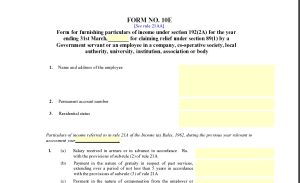Table of Contents
ToggleComprehensive Outline (Table Format)
| Section | Heading/Subheading | Description |
|---|---|---|
| 1 | H1: New Tax Regime More Beneficial Than the Old Tax Regime to All Taxpayers, F.Y. 2025-26 as per Budget 2025 | Introduces and compares both regimes comprehensively |
| 2 | H2: Understanding the Concept of Old and New Tax Regimes | Explains fundamental principles of each regime clearly |
| 3 | H2: Key Highlights of the New Tax Regime under Budget 2025 | Describes updated provisions and significant advantages |
| 4 | H2: Simplified Tax Slabs for F.Y. 2025-26 | Illustrates the revised slab rates in detail |
| 5 | H2: How the New Tax Regime Promotes Ease of Filing | Highlights simpler compliance and minimal documentation |
| 6 | H2: Comparison Between Old and New Tax Regimes | Demonstrates the differences through a structured table |
| 7 | H2: Who Benefits Most from the New Tax Regime? | Identifies major beneficiary categories among taxpayers |
| 8 | H2: Impact on Salaried Individuals | Emphasizes how employees benefit directly |
| 9 | H2: Impact on Senior Citizens and Pensioners | Explains tax relief and convenience for retirees |
| 10 | H2: Business and Professional Income under the New Regime | Highlights advantages for entrepreneurs and professionals |
| 11 | H2: Role of Standard Deduction and Rebates | Analyzes available deductions and rebates thoroughly |
| 12 | H2: Why the Government Encourages the New Tax Regime | Explains the policy intent and long-term economic goals |
| 13 | H2: Common Misconceptions About the New Regime | Dispels myths with factual clarification |
| 14 | H2: How to Switch Between Old and New Tax Regimes | Outlines the exact step-by-step switching procedure |
| 15 | H2: FAQs | Presents six detailed, frequently asked questions |
| 16 | H2: Conclusion | Summarises key benefits and final insights |
| 17 | External Link | Directs readers to the official Income Tax Department site |
️ New Tax Regime More Beneficial Than the Old Tax Regime to All Taxpayers, F.Y. 2025-26 as per Budget 2025
Undoubtedly, the New Tax Regime, More Beneficial Than the Old Tax Regime F.Y. 2025-26 continues to empower taxpayers through simplicity and fairness. Since the Budget 2025 introduced enhanced benefits, this progressive structure has transformed how individuals, pensioners, and professionals manage taxes. Moreover, because it combines lower rates, higher rebates, and reduced paperwork, it not only eases compliance but also strengthens financial confidence across all income groups.
Additionally, before any taxpayer selects a suitable regime, one must first comprehend how both systems operate, what reforms the government introduced, and why experts now consider the New Tax Regime the most transparent and beneficial model for F.Y. 2025-26.
Understanding the Concept of Old and New Tax Regimes
To begin with, the Old Tax Regime offered numerous deductions under Sections 80C, 80D, 24(b), HRA, and LTA, which allowed taxpayers to minimise taxable income strategically. Nevertheless, because this regime required extensive documentation and strict proof submissions, many found the process time-consuming and complicated.
In contrast, the New Tax Regime More Beneficial Than the Old Tax Regime F.Y. 2025-26, which originated in Budget 2020 and evolved further under Budget 2025, completely redefines taxation simplicity. It eliminates most deductions yet compensates taxpayers by offering lower slab rates and expanded rebate thresholds. As a result, taxpayers can easily calculate liability without relying heavily on investment-based deductions.
Consequently, the New Regime ensures neutrality, flexibility, and simplicity, thereby enabling individuals to plan taxes efficiently and independently.
Key Highlights of the New Tax Regime under Budget 2025
Indeed, the Union Budget 2025 introduced remarkable upgrades that solidify why the New Tax Regime surpasses the old framework. Notably, it:
-
Raises the rebate limit under Section 87A to ₹12 lakh.
-
Continues the standard deduction of ₹75,000 for both salaried employees and pensioners.
-
Ensures zero tax liability for individuals earning up to ₹12 lakh annually.
-
Introduces simplified ITR forms featuring auto-populated fields for instant accuracy.
-
Allows salaried individuals to switch between regimes every financial year effortlessly.
Through these initiatives, the government clearly demonstrates its vision of a uniform, transparent, and efficient taxation system that genuinely benefits every income class.
Simplified Tax Slabs for F.Y. 2025-26
Because Budget 2025 continues its reformative approach, the New Tax Regime, More Beneficial Than the Old Tax Regime F.Y. 2025-26 introduces crystal-clear slab structures as shown below:
| Income Range (₹) | Tax Rate (New Regime) |
|---|---|
| Up to ₹3,00,000 | Nil |
| ₹3,00,001 – ₹6,00,000 | 5% |
| ₹6,00,001 – ₹9,00,000 | 10% |
| ₹9,00,001 – ₹12,00,000 | 15% |
| ₹12,00,001 – ₹15,00,000 | 20% |
| Above ₹15,00,000 | 30% |
Important Transition: Under Section 87A, taxpayers with annual income up to ₹12 lakh enjoy zero tax liability, which undoubtedly reinforces inclusivity and equity.

⚙️ How the New Tax Regime Promotes Ease of Filing
Furthermore, taxpayers file returns more efficiently under the New Tax Regime, primarily because the government strategically simplified the compliance process. This regime actively:
-
Removes most exemptions and deductions, simplifying calculations.
-
Enables pre-filled ITR forms, ensuring time savings.
-
Eliminates the need for manual proof submission, saving effort.
-
Accelerates processing, which guarantees faster refunds.
As a result, every taxpayer focuses more on earning and saving rather than decoding paperwork. Additionally, modern Excel-based tax calculators automatically compare both regimes, helping employees choose the most profitable option seamlessly.
Comparison Between Old and New Tax Regimes
| Aspect | Old Regime | New Regime (F.Y. 2025–26) |
|---|---|---|
| Deductions & Exemptions | Multiple (HRA, LTA, 80C, etc.) | Minimal |
| Tax Rates | Higher | Lower |
| Rebate Threshold | ₹5,00,000 | ₹12,00,000 |
| Compliance | Complex | Simplified |
| Ideal For | High investment planners | Salaried employees & new earners |
Hence, as data clearly indicates, the New Tax Regime, More Beneficial Than the Old Tax Regime F.Y. 2025-26, offers broader relief, lesser compliance, and a cleaner structure that aligns with modern taxpayer expectations.
Who Benefits Most from the New Tax Regime?
Because of its adaptable design, the New Tax Regime benefits:
-
Middle-class salaried employees seeking simplicity
-
Retired pensioners with fewer deductions
-
Self-employed professionals managing flexible expenses
-
Young taxpayers prefer liquidity and financial freedom
Therefore, since it lowers the effective tax burden even without deductions, it empowers millions to retain more disposable income and encourages saving wisely.
Impact on Salaried Individuals
Evidently, the New Tax Regime, More Beneficial Than the Old Tax Regime F.Y. 2025-26 simplifies financial management for salaried individuals. Employees now:
-
Enjoy lower rates instantly, without complex calculations
-
Retain liquidity for essential needs
-
Avoid unnecessary investment compulsion
-
File returns faster, saving valuable time
Moreover, because HR systems now integrate automatic dual-regime comparison, every employee conveniently identifies the more rewarding option before filing.
Impact on Senior Citizens and Pensioners
Equally important, senior citizens and pensioners significantly benefit since they now experience:
-
Higher exemption thresholds
-
Simplified compliance
-
Reduced tax liability up to ₹12 lakh
-
Minimal documentation requirements
Consequently, retirees manage taxes effortlessly, achieving peace of mind and enhanced financial security in their post-retirement years.
Business and Professional Income under the New Regime
Professionals and entrepreneurs equally appreciate that the New Tax Regime, More Beneficial Than the Old Tax Regime F.Y. 2025-26 ensures:
-
Predictable taxation without exemptions
-
Simplified accounting, reducing administrative load
-
Reduced rates for incomes up to ₹15 lakh
-
Faster assessments, improving ease of doing business
Therefore, this transparent structure motivates greater entrepreneurship and sustains India’s economic momentum.
Role of Standard Deduction and Rebates
Undoubtedly, the standard deduction of ₹75,000, combined with the enhanced ₹12 lakh rebate, reshapes tax relief entirely. These provisions eliminate liability for a large section of citizens, ensuring fairness and inclusivity.
Thus, millions of taxpayers experience improved savings potential, affirming that the New Tax Regime truly benefits every income group.
️ Why the Government Encourages the New Tax Regime
The government intentionally promotes the New Tax Regime because it:
-
Simplifies the system for all citizens
-
Reduces administrative burden on authorities
-
Boosts voluntary compliance among taxpayers
-
Stimulates consumption-driven growth
Ultimately, this reform supports India’s transition toward a transparent, sustainable, and growth-oriented fiscal model.
❌ Common Misconceptions About the New Regime
Although misconceptions circulate, the New Tax Regime remains misunderstood. Let’s clarify:
-
“You can’t claim any deductions” — False; the standard deduction still applies.
-
“It doesn’t benefit most taxpayers” — Incorrect; the majority earn under ₹12 lakh.
-
“Switching is irreversible” — Wrong; salaried individuals can switch annually.
By debunking these myths, taxpayers confidently adopt the regime that suits their finances best.
How to Switch Between Old and New Tax Regimes
To transition smoothly, taxpayers should:
-
Log in to the Income Tax e-Filing Portal.
-
Select the appropriate income category (salaried/business).
-
Choose the preferred regime in the ITR form.
-
Verify and file, ensuring accuracy.
Consequently, switching regimes now becomes fast, transparent, and fully digitalised.
❓ Frequently Asked Questions (FAQs)
Q1: Is the New Tax Regime More Beneficial Than the Old Tax Regime F.Y. 2025-26 mandatory?
No. Taxpayers can voluntarily choose between the two regimes each year.
Q2: What rebate does Section 87A offer?
It offers 100% rebate for income up to ₹12 lakh, resulting in zero tax.
Q3: Can salaried individuals revert to the Old Regime next year?
Absolutely. They can switch annually before filing returns.
Q4: Does the New Regime include a standard deduction?
Yes, ₹75,000 applies to all salaried and pensioned taxpayers.
Q5: Is the New Regime beneficial for small businesses?
Certainly, it simplifies compliance and promotes consistent profitability.
Q6: Can taxpayers calculate automatically?
Yes, by using Automatic Excel-based income Tax Calculators, anyone can instantly compare both regimes.
✅ Conclusion
In summary, the New Tax Regime is More Beneficial Than the Old Tax Regime F.Y. 2025-26 under Budget 2025, symbolising India’s commitment to transparent, equitable, and efficient taxation. By offering reduced rates, extended rebates, and easier compliance, it empowers taxpayers across all demographics.
Therefore, as individuals embrace this streamlined approach, they contribute not only to personal savings but also to national growth, ensuring India’s tax framework remains both fair and futuristic.


